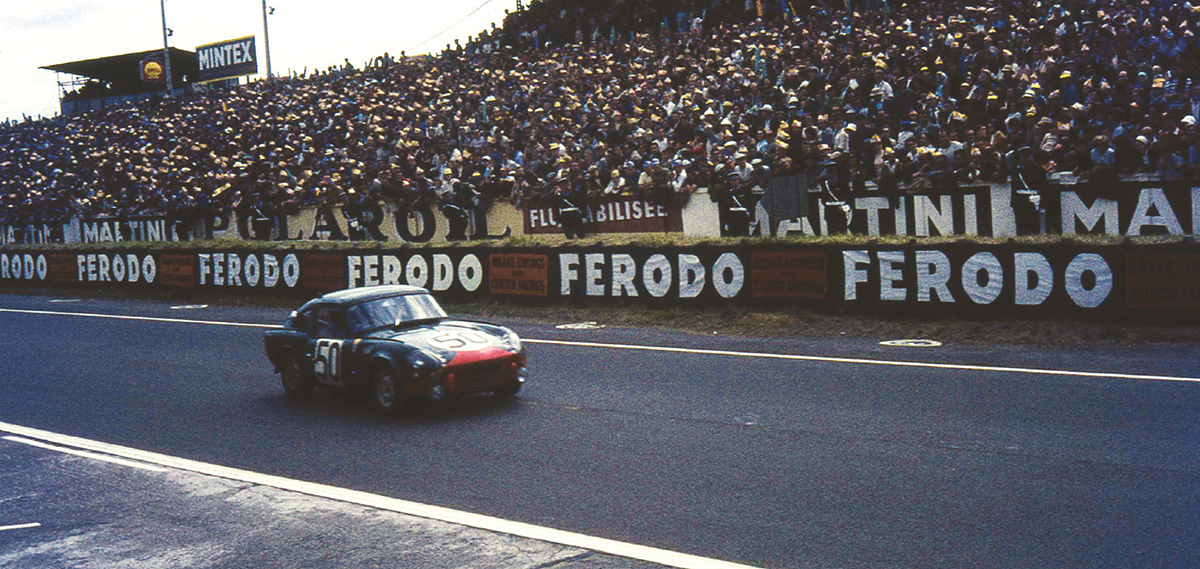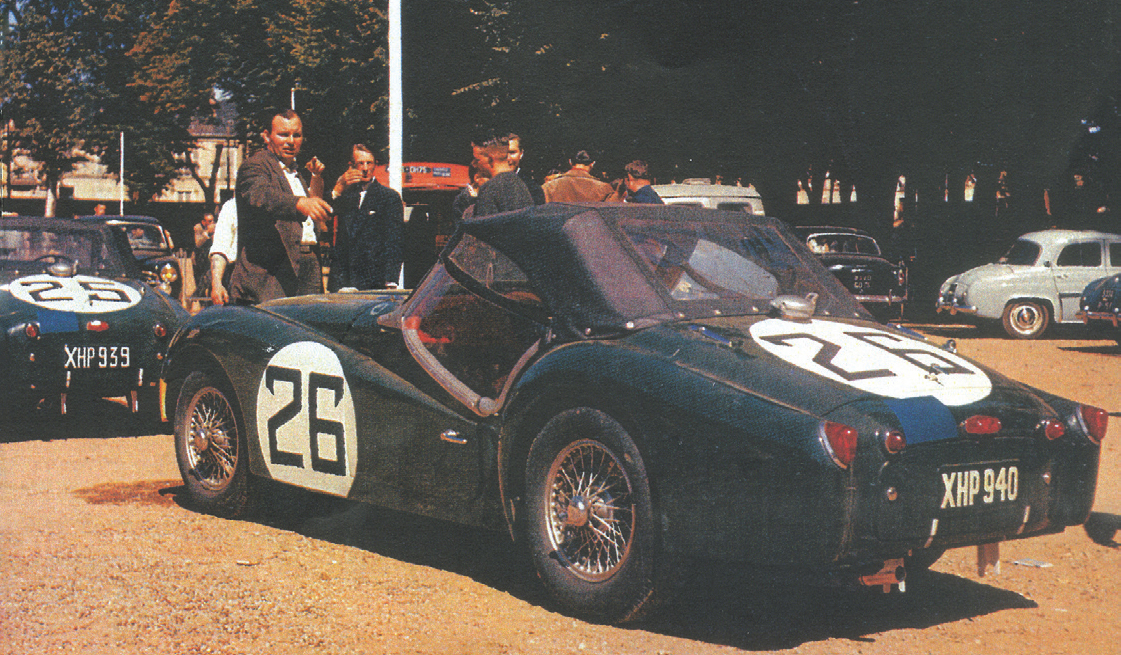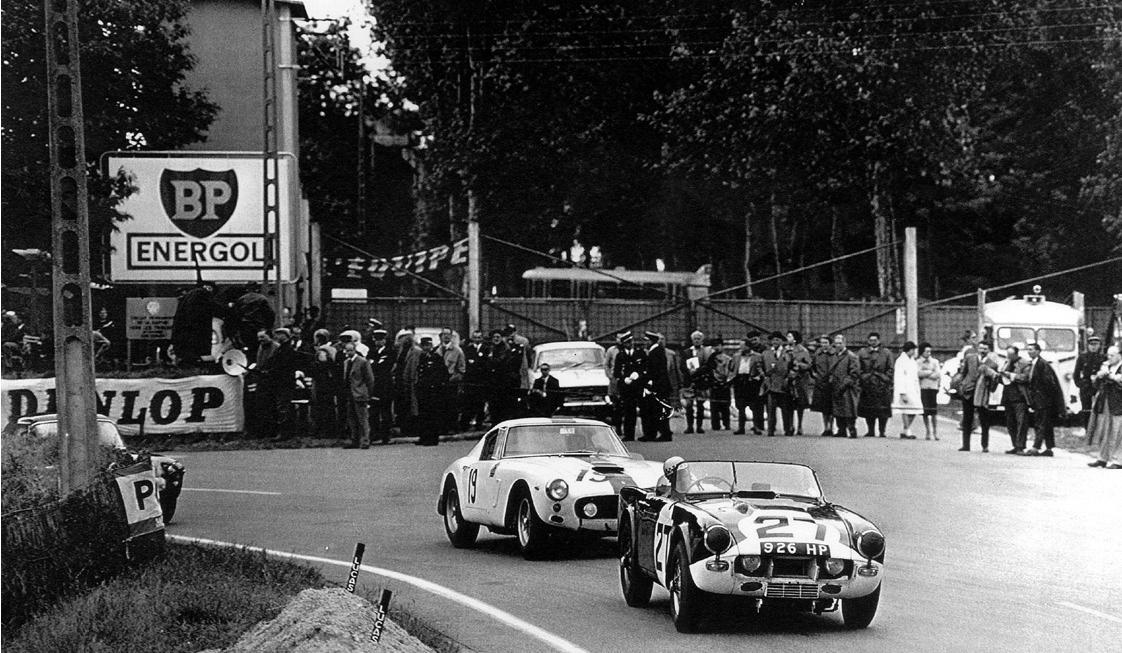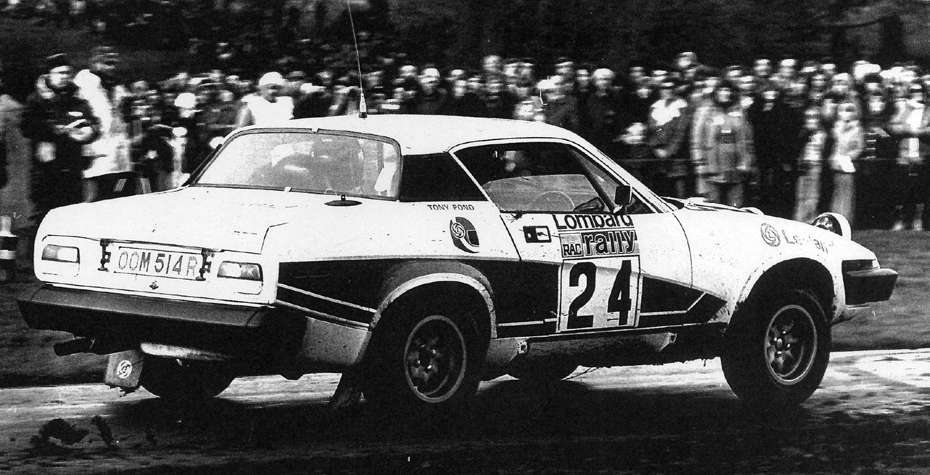
The ‘works’ TR2’s biggest team success came in the 1954 French Alpine rally, when these cars performed extremely well and won the Team Prize. Left to right: Ken Richardson, Rob Slotemaker, Maurice Gatsonides and Hans Tak.
RACING, RALLYING AND RECORD-BREAKING
ALTHOUGH THERE was some sporting activity in the 1920s and 1930s – especially when Donald Healey was at the engineering helm – this didn’t compare with the work of factory teams from the 1950s to the 1970s. The arrival of the TR2 then made everything possible. Once Ken Richardson had achieved 124 mph on the Belgian Jabbeke Road, and private owners had won the RAC rally, a ‘works’ team was soon established.
For the next six years, the ‘works’ TRs built themselves a great rallying reputation across Europe. If the TRs were not crashed by their enthusiastic drivers, they were always in contention for major class awards. With a tiny team of mechanics, Triumph would enter only those events where reliability could show well – usually the Tulip, Alpine and Liège-Rome-Liège rallies. Sheer gutsy driving and persistent endeavour produced results. From the first coupé win in the 1954 Alpine (by Maurice Gatsonides) to the last class win of all (by David Seigle-Morris in the 1960 Alpine), the ‘works’ TRs were always competitive. Rarely fast enough to fight for outright victory – their only major triumph was by Paddy Hopkirk in the 1958 Circuit of Ireland – there were always great class wins and team prizes to be picked up. Notable results included Ken Richardson’s fifth place in the 1955 Liège, Johnny Waddington’s class win in the 1957 Tulip with a disc-braked TR3 and Bernard Consten’s third overall in the 1957 Liège.
Then with the TR3As, there was Paddy’s Circuit victory in 1958, Ron Gouldbourn’s class win in the 1958 Tulip and Keith Ballisat’s truly excellent fourth overall in the Alpine of the same year. Maurice Gatsonides took fifth in the 1958 Liège, Keith Ballisat took a remarkable second place in the 1959 Tulip (behind the Morley twins in their Jaguar 3.4), and Roger de Laganeste also took a class award in the Alpine, but after Annie Soisbault took an amazing fourth place in the Liège of the same year it was nearly all over for the sidescreen TRs.
The Leyland takeover of 1961 came too late to save the ‘works’ team, but within weeks, the sales department was nagging for its return. In 1962 technical director Harry Webster reopened the ‘works’ team. This time there was a determined development programme, with engines getting major tune-up jobs, transmissions getting limited-slip differentials, and most body panels of the TR4s being pressed from aluminium sheet. In two years the TR4s took fourth place in the 1962 Alpine, set fast times in the 1963 Tulip and were sixth overall in the Geneva.
In 1964 Harry Webster got his wish to return to the Le Mans 24-Hour race, and a set of rally cars were also built. These were 105-bhp 1.1-litre cars with entirely different cylinder heads and Weber carburettors, with close-ratio gearboxes, aluminium body panels, GRP fastback styles and much more. These noisy and intractable extroverts took class wins at Le Mans and the Tour de France, and an amazing second overall in the Geneva rally, plus victory in the entire Prototype category of the French Alpine rally.

The ‘works’ TR2’s biggest team success came in the 1954 French Alpine rally, when these cars performed extremely well and won the Team Prize. Left to right: Ken Richardson, Rob Slotemaker, Maurice Gatsonides and Hans Tak.

In 1965 the factory prepared this intriguing Spitfire ‘one-off’ race car, based on the Le Mans cars, which contested events in Macau and the Far East in the following months.
At the same time a team of high-performance 2000 saloons tackled the rough events which were already multiplying in the calendar. Roy Fidler took sixth in the RAC rally, and the 2000s then won their class in the Tulip and the RAC of 1965.
From 1969 all of British Leyland’s motorsport was centred on the old BMC Competitions Department at Abingdon. Manager Peter Browning’s original aim was to request lightweight, two-door, Dolomite Sprint-style cars, but this idea was dismissed; the fallback was to use 2.5 PIs as ‘rough road tanks’, and (later) Dolomite Sprints for saloon car racing and for rallying.

Although the Le Mans Spitfires had only 1,147cc, they could reach and exceed 130 mph – for the full twenty-four hours of the race.

Triumph entered three TR3S cars at Le Mans in 1959, these looking like standard machines, but having 160-bhp twin-cam engines.

The ‘works’ TR3S of 1959 had a longer wheelbase than standard, a twin-cam engine and glass-fibre body panels.

The ‘works’ TRS cars of 1960 and 1961 had different colour noses, to aid recognition as they flashed past the pits. The third of the trio had a yellow nose.

The engine for the Le Mans was a specially designed twin-overhead-camshaft 2-litre unit which soon gained the nickname of ‘Sabrina’.

One of the 1961 TRSs at Le Mans, closely followed by a Ferrari 250GT. Driven by Peter Bolton and Keith Ballisat, it finished ninth overall, and was one of the Team Prize winners.

Triumph planned to enter ‘Conrero’-constructed TRSs at Le Mans in 1962, but only one car was ever completed.
A new set of Mk Is took class wins on the RAC rally; then new Mk IIs were built for the 16,000-mile Daily Mirror World Cup Rally which linked London with Mexico City. It was a phenomenal high-speed/rough-road challenge, which the 2.5 PIs so nearly won, for Brian Culcheth and Paddy Hopkirk took second and fourth overall. However, except for Brian Culcheth’s ‘Team Castrol’ in 1971 the ‘World Cup’ cars were not used again.
In the meantime, the ‘works’ motorsport department ran 16-valve Dolomite Sprints, but after the TR7 had been launched, all that running gear could be used in the first of the TR7s. By the time it was a fully developed rally car, in 1977, it was an effective machine. The first outright victories had been achieved, reliability was coming on apace, and there was much hope for the future, when V8-engined versions were expected.
There were two third overall places in 1976 – in the Manx and Castrol 76 rallies –and in a European-wide 1977 programme Tony Pond won the Belgian Boucles de Spa event, and there were several second and third places. Five-speed gearboxes and four-wheel disc brake kits had been developed by this time, the overall package being much improved. John Davenport had taken over as motorsport director, the technical team had been strengthened, and there had been a huge development effort.

Tony Pond and Fred Gallagher used this TR7 V8 to win the 24-hour Ypres event in 1980.
For the next three seasons Abingdon concentrated its efforts on the Triumph TR7 V8 (which was really a TR8, but that car had not then gone on public sale). The 3.5-litre engines were gradually improved – at first they used twin dual-choke Weber carburettors with Offenhauser manifolding and produced 300 bhp, this set-up then being replaced by a four dual-choke installation and (on occasion) by a Pierburg fuel-injection system.

The original ‘works’ TR7s had four-cylinder engines. This model is being driven by Tony Pond in the 1977 RAC rally, where it took eighth place.
In a straight line, and on tarmac, there was no doubt that the TR7 V8 was Britain’s fastest rally car of the period, but it still struggled to be competitive on gravel. Although many distinguished drivers grappled with the ‘works’ cars – Roger Clark, Timo Mäkinen, Per Eklund, Simo Lampinen and John Buffum (of the USA) among them – only Tony Pond completely mastered the beast. Tony clearly loved the TR7 V8, winning four international events outright, all of them on tarmac – including two successes in the Manx Trophy event – and those of us who saw the low, wide and fat-tyred TR7 V8s hurtling their way around the stages of the Isle of Man hold exciting memories of a great rally car.
Before the end of the 1980 season, though, the death knell had sounded for the TR7 V8 rally programme, and at the end of the year the works at Abingdon themselves came under threat. The rallying effort was rapidly wound down and attention turned to Rover 3500s and saloon car racing – which brought Triumph’s long ‘works’ rallying career to an end.
In the end, as in the beginning, the TR had been a success – but there was never to be a Revival.

Race and rally drivers sometimes shared the same car at special-for-TV events; here is Alan Jones in a TR7 V8 at the Eaton Yale Rallysprint of 1980.